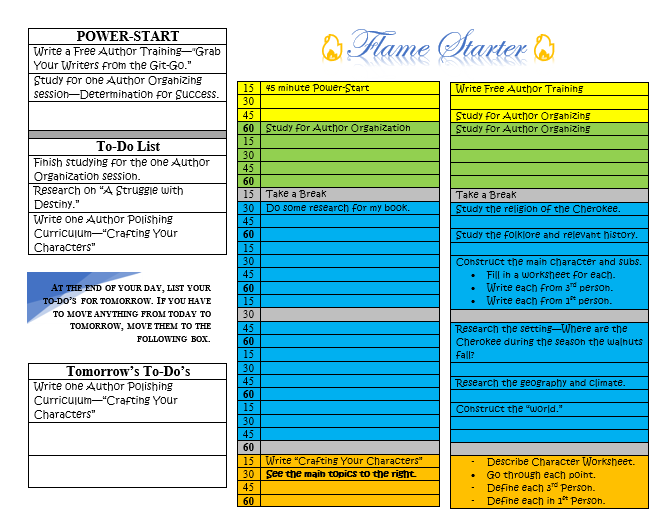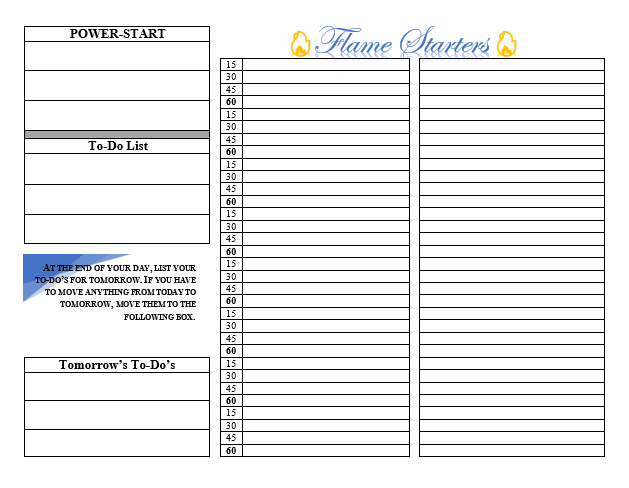Overcoming the "I Forgots"
Today, I want to share how to improve your memory with this simple tool!
My memory is horrible! I’m sure many of you can relate when I say that I can walk from one room into another and forget why I went in there. I forget my children’s names in the heat of the moment and call them by everyone else’s name, including the dog’s! I can never remember which birthday goes with which child when the doctor or pharmacist asks me. I have to sit and call out the birthdays in order— but I do have four kiddos, so you have to cut me a little slack, and I do get it eventually. I forget what’s on my agenda from one moment to the next, which is why I carry my schedule on my phone, and I forget what I need to ask the doctor, which why I make scrupulous notes. As I said, my memory is horrible!
One thing I don’t forget is clients and workload. Why is that? Because I have a system that helps me schedule my day and remember what needs to be done.
Today, I’m going to share my system with you.
The secret is to be organized. You can do this in a number of ways. You can use Trello, one of my personal favorites, or with a Daily To-Do List—also a personal favorite.
The website, Mobile Technology Product, said that using the correct organizational tools can improve time management by 38%.
I use Trello to organize my macro goals.
Your macro goals are your big goals. What am I going to do over the next week? Month? Year? And I put them in order of importance, date them, and put them in categories. If you need help figuring out Trello, I’d love to share some time with you and show you how to make that work for you and your business or book.
Figuring out your macro goals is also the first part to figuring out your Daily to-do list.
I created a daily to-do list, called the Flame Starter, which is a great tool for planning your day. It’s not like any other To-Do List. I’m going to give it to you for free today. But first I want to show you how to use it and how I use it to plan my day.

It’s vital to have a plan. Benjamin Franklin said, “If you fail to plan, you plan to fail.”
The Flame Starter starts the day before. This is when you plan out the day. You don’t want to waste your morning doing this. Plus, come the end of the workday, you know exactly what you need to complete the next day. Why not write it down then? This helps you sleep better because you’re not worrying about forgetting to do those tasks the next day, helps make your day more efficient, and helps you not waste the next morning trying to remember what you need to do.
The Flame Starter begins with what I call a "Power Start." It makes your day more efficient and jumpstarts your day. With the Power Start, you turn off the sound on your phone, shut out any distractions, and spend 45 minutes doing nothing but the first two tasks in that Power Start area on your Flame Starter To-Do List. Not only does it help you get at least one of these things finished, which is proven to give you a psychological boost, but it’s also proven to make the rest of your day more efficient. It motivates you. “Look how much I’ve already done!” It puts wind under your sails, so to speak.
It’s very simple to set up your Power Start period. Pick something small that needs to be done. I usually jump on my lessons. Yes, I’m constantly learning, too. If you’re not learning, you’re not growing. And if you’re not growing. And if you’re not growing, you’ll grow stagnant.
After you figure out your Power Start, you’ll list the rest of your day. Now, you’re not going to want to list every single thing that needs to be done for the whole month, or even the whole week, on today’s schedule.
I list a macro goal. A macro goal is a big goal that you want to work toward.—“I want to write and publish a book.”
Then I break it down into smaller goals. These are smaller goals that will lead you to the big goal.—“ I will research, organize, write, proofread and edit, publish, and then market my book." These smaller goals are called micro goals.
I help authors write fiction books as well as helping business owners, coaches and consultants write their books to promote their business, get seen in their clients, get speaking engagements, and increase their revenue. So if you’re writing a fiction, one example of a macro goal might be to do the research for the first five chapters of the book. The micro goals, then, to hit the “Research” goal, might be: (1) research the setting (climate, geography, noteworthy news, etc.); (2) research the characters (this also includes the customs, ways, folklore, religions, etc. of the people in your story); (3) research the history of the area and of the people; (4) etc.
Next, you’re going to set due dates on your smaller steps. What needs to be done now? What can be done later?
Then, you’re going to set a schedule. “The due date for this is (next Monday), so I must do (this much) every day.”
Make your weekly schedule—"On top of writing on by book, on Monday, I’ll work on getting all of my author page on Facebook. I’ll also set up my other social media sites for the week. On Tuesday, I’ll read after an author in my genre. On Wednesday, I’ll…” You get the idea.
Use this schedule to set your daily goals.
How do you know what to schedule?
Do you have any goals for the day? Are you in the research stage? What, specifically, are you going to research? The setting? The characters? The population? Set this down as a goal.
Is your book in the writing stage? You want to schedule yourself to write a specific number of pages on your to-do list. The average writer will pen about 1,000 words (four pages) a day. Start there.
Is your book the only thing you do in the writing part of your career? Do you have a blog, an author page, or other social media sites? If so, schedule those in.
Out of those things that merit a place on your to-do list, you must choose those which are the most important, and list them for that day.
How do you know what’s important?
You’re still going to have too many things on your to-do list. You’re going to need to narrow it down. You should only have, at the most, two things on your list other than writing on your book on any given day. How do you do that? How do you choose what goes on that list?
What has to be done *today? These things, obviously, go on the list. What pressing things are coming up on your calendar? Are they bigger ticket items that need to be done in steps? What little steps can you do each day leading up to the deadline? Schedule these on your to-do list.
How do you know what order to put it in?
After you have narrowed down your to-do list written out for the day, you must put it in the order you’ll follow. But how do you structure your to-do list?
You ALWAYS start with your Power-Start. I would do my most important “extra” on the To-Do List next.
Perhaps you choose to write 1,000 words on your book for your Power Start. If you do, stop after you complete your 1,000 words and do your second “extra.” If you have more time left in your blocked-off time for the Power Start after your second To-Do is finished, write more. Fill that 45-minutes with those two things.
As for the rest of the list, I always put the list in order of difficulty. I put the most mentally taxing tasks in the morning, since this is when I’m the most alert. I save the less mentally-tasking tasks for the early afternoon, since this is when I seem to slow down and feel groggy. This is typically when I run errands. Then I finish up the day with more of the mentally-tasking tasks since I get my second wind in the late afternoon. Your day may work out differently.
You want to finish your workday by writing out your to-do list for the next day. We’ve already discussed the reasons behind this.
Now, something that’s great about my Flame Starter is that it’s set up in 15-minute increments rather than as a daily planner with the hours listed out. And those 15-minute increments don’t have times beside them. This is vital because if you have a time beside your To-Do item and a client calls or your child has a boo-boo that needs to be attended to or an old friend shows up, there goes 9-o-clock and 9:30. What do you do with those things that were scheduled at that time? Do you forget about them? They still need done! Suddenly, you’re behind on your schedule. Or you skip them and forget to do them later. With the Flame Starter, there is no set schedule, just a set time to work on everything.
The reason the schedule is set up in 15-minute increments is simple. This does NOT mean that you are only going to work on each item for 15-minutes. The 15-minute increments make it easy to schedule in time-blocks. You schedule each for 45-minutes or an hour and a half and work on them for that timeframe, then you move on.
This also helps you to resist jumping between tasks. According to the University of Michigan, multitasking decreases productivity by 20-40% more than those who focus on one project at a time. The time lost switching among tasks increases the complexity of those tasks. SO, no task-jumping!
You must be careful to be honest with yourself, however, as far as how long each task will take and not overbook! This can be discouraging!
If you’d like a free copy of my Flame Starter, please email me at [email protected]! I’ll send you a free copy. Along with your free copy, if you like, I’ll also give you a free consultation on how to use the Flame starter to get started on your book! Just email me at [email protected] and let me know that you want a free copy of my Flame Starter. I’ll get that right out to you!



About the Author
Nishoni Harvey
Growing up, I never feel like I’m good enough. This follows me into adulthood and is only solidified when I send my first book into publishers to only have them reject me time and time again.
Finally, my mom suggests a publisher in North Carolina. They publish my book, and it sells over 70 books right out of the gate, making it a bestseller, but it soon falls out of the rankings. I don’t know how to keep it there. Again, I feel like a failure.
Since then, I’ve written a chapter for two other published books, published my second fiction book, ghostwritten 16 nonfiction books, and authored two of my own nonfiction, self-help books.
Sometime between then and now, I have a lightbulb moment. I am on another downward swing with my bipolar depression, and I am thinking about how unhappy I am. It’s then that I think how happy I was during my years spent teaching children and teenagers and how much I love writing. “Why not do both?” I think. “I could teach others to write their book!”
I start my business with great motivation and ambition, but the clients don’t come. Depression starts to seep in again, and I start to give up. I keep doing the job that I’m contracted on, formatting a book for a plastic surgeon in Australia, but I drop everything else and start teaching English as a second language.
One day it hits me, Doctor Barnouti is using his book to show that he’s an authority in his niche and gaining clients! I teach others to do that!
Today, I help business owners struggling to get their names out to write their book so they can show themselves as an authority in their niche, get speaking engagements, and reach their ideal client through my business, Authors Aflame.
